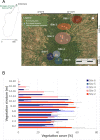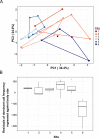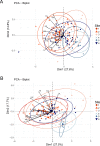Population diversification in the frog Mantidactylus bellyi on an isolated massif in northern Madagascar based on genetic, morphological, bioacoustic and ecological evidence
- PMID: 35358210
- PMCID: PMC8970393
- DOI: 10.1371/journal.pone.0263764
Population diversification in the frog Mantidactylus bellyi on an isolated massif in northern Madagascar based on genetic, morphological, bioacoustic and ecological evidence
Abstract
In the processes that give rise to new species, changes first occur at the population level. But with the continuous nature of the divergence process, change in biological properties delimiting the shift from "individuals of divergent populations" towards "individuals of distinct species", as well as abiotic factors driving the change, remain largely ambivalent. Here we study diversification processes at the population level in a semi-aquatic frog, Mantidactylus (Brygoomantis) bellyi, across the diverse vegetation types of Montagne d'Ambre National Park (MANP), Madagascar. Genetic diversity was assessed with seven newly developed microsatellite markers as well as mitochondrial DNA sequences and concordance with patterns of ecological, morphological, and bioacoustic divergence evaluated. We found M. bellyi lacking mitochondrial differentiation within MANP, while microsatellite datasets partitioned them into three highly differentiated, geographically separated subpopulations (with indications for up to five subpopulations). The molecular grouping-primarily clustering individuals by geographic proximity-was coincident with differences in mean depth and width of waters, suggesting a possible role of fluvial characteristics in genetic exchange in this stream-breeding species. Genetic clustering not consistent with differences in call properties, except for dominant call frequencies under the two-subpopulations model. Morphological divergence was mostly consistent with the genetic clustering; subpopulations strongly differed by their snout-vent length, with individuals from high-elevation subpopulations smaller than those from populations below 1000 m above sea level. These results exemplify how mountains and environmental conditions might primarily shape genetic and morphological divergence in frog populations, without strongly affecting their calls.
Conflict of interest statement
The authors have declared that no competing interests exist.
Figures





Similar articles
-
Repeated divergence of amphibians and reptiles across an elevational gradient in northern Madagascar.Ecol Evol. 2023 Mar 16;13(3):e9914. doi: 10.1002/ece3.9914. eCollection 2023 Mar. Ecol Evol. 2023. PMID: 36937068 Free PMC article.
-
Sympatric lineages in the Mantidactylus ambreensis complex of Malagasy frogs originated allopatrically rather than by in-situ speciation.Mol Phylogenet Evol. 2020 Mar;144:106700. doi: 10.1016/j.ympev.2019.106700. Epub 2019 Dec 3. Mol Phylogenet Evol. 2020. PMID: 31809850
-
Revision and phylogeny of narrow-mouthed treefrogs (Cophyla) from northern Madagascar: integration of molecular, osteological, and bioacoustic data reveals three new species.Zootaxa. 2015 Mar 24;3937(1):61-89. doi: 10.11646/zootaxa.3937.1.3. Zootaxa. 2015. PMID: 25947461
-
A new riparian Mantidactylus (Brygoomantis) frog from the Tsaratanana and Manongarivo Massifs in northern Madagascar.Zootaxa. 2018 Sep 30;4486(4):575-588. doi: 10.11646/zootaxa.4486.4.10. Zootaxa. 2018. PMID: 30313742
-
Description of the lucky Cophyla (Microhylidae, Cophylinae), a new arboreal frog from Marojejy National Park in north-eastern Madagascar.Zootaxa. 2019 Aug 5;4651(2):zootaxa.4651.2.4. doi: 10.11646/zootaxa.4651.2.4. Zootaxa. 2019. PMID: 31716910
Cited by
-
Repeated divergence of amphibians and reptiles across an elevational gradient in northern Madagascar.Ecol Evol. 2023 Mar 16;13(3):e9914. doi: 10.1002/ece3.9914. eCollection 2023 Mar. Ecol Evol. 2023. PMID: 36937068 Free PMC article.
References
-
- Stanton DWG, Frandsen P, Waples RK, Heller R, Russo IRM, Orozco-terWengel PA, et al.. More grist for the mill? Species delimitation in the genomic era and its implications for conservation. Conserv Genet. 2019;20: 101–113. doi: 10.1007/s10592-019-01149-5 - DOI
-
- Hillis DM. Species delimitation in herpetology. J Herpetol. 2019;53: 3–12. doi: 10.1670/18-123 - DOI
-
- Rasolonjatovo SM, Scherz MD, Hutter CR, Glaw F, Rakotoarison A, Razafindraibe JH, et al.. Sympatric lineages in the Mantidactylus ambreensis complex of Malagasy frogs originated allopatrically rather than by in-situ speciation. Mol Phylogenet Evol. 2020;144: 106700. doi: 10.1016/j.ympev.2019.106700 - DOI - PubMed
Publication types
MeSH terms
Substances
LinkOut - more resources
Full Text Sources
Miscellaneous

